5: The Annual Pilgrimage to Makkah: Hajj
See Also Hajj... Videos, Pictures, Resources
What is Hajj and who performs Hajj?
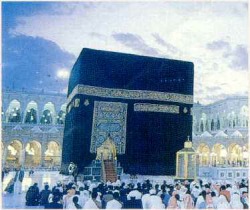
"And proclaim that the people shall observe Hajj pilgrimage. They will come to you walking or riding on various exhausted (means of transportation). They will come from the farthest locations."
(Quran 22:27)
The literal meaning of the word ‘Hajj’ is ‘to visit’. Every year, in the Islamic month of Dhu Al-Hijjah(last month of Islamic Calendar), Muslims (male and female) from all over the world travel to Makkah/Mecca and several other places to perform certain rites in memory of the past Prophets and to declare their devotion to Allah.
“Pilgrimage thereto is a duty men owe to Allah – those who can afford the journey.”
(Quran 3:97)
Hajj is the fifth pillar of Islam, which automatically makes it compulsory. However, it is only compulsory on those who are financially and physically able to perform it.
When is Hajj performed?
Hajj is performed during the 8th to the 12th (five to six day period) of the last month of the Islamic Calendar: Dhu Al-Hijjah
Why is Hajj Performed? What is the Purpose of Hajj?

Hajj is all about combining three of the other four pillars of Islam (Shahadah: declaring the faith, Salaah: prayer, and Zakah: charity) and actually developing a sense of Allah and understanding why Muslims worship Him. It also helps to strengthen the Islamic identity of a Muslim by teaching love, tolerance and patience through experiences.
When a person performs Hajj, they must have the intention of improving themselves in both manners and actions. They must also not have sexual relations or do anything that will distract them from the point of Hajj: worshipping Allah. The result is that their every previous sin will be forgiven and they will be completely purified once the Hajj is over. However, this is only true for those who are sincere in the Hajj. This is the reason why Hajj is a very big deal for Muslims.
The Prophet (p.b.u.h) said, "Whoever performs Hajj for Allah's pleasure and does not have sexual relations with his wife, and does not do evil or sins then he will return (after Hajj free from all sins) as if he were born anew."
Hajj brings about unity and equality, along with humbleness and respect for Allah. There is no arrogance, because no Muslim has any higher status than the one standing next to him/her during Hajj. Muslims also learn about submitting themselves to the will of Allah and so it has a very big impact on their lives and brings about the desire to improve oneself and become a better Muslim.
Significance of Hajj
- Hajj was the Sunnah (practice) of the Prophet Muhammad (s).
- The places passed during Hajj, such as Mina, Muzdalifah, Arafat and Makkah all have some linkage to past Prophets, like Ibrahim (Abraham) and Ismail (a.s.).
- Muslims believe that the Day of Judgement will take place at Arafat, a place passed during Hajj.
Clothing in Hajj - Equality and Unity of the Ummah
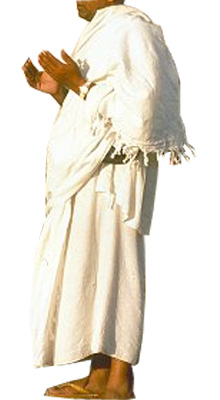
Muslims wear certain clothing during Hajj, known as the Ihram. The Ihram is worn to strip away any superiority or inferiority in status, and to show every Muslim as equal. Muslim males drape themselves in two pieces of unstitched white clothing made of the same material. White symbolizes purity.
Muslim women wear modest clothing, which is not as specific as the male’s. However, it should be simple and not bright. Cultural clothing is accepted although perfumes are not allowed.
The clothing stresses the equality between every Muslim and brings about a unity of the Ummah (worldwide Muslim community), as it is the same people (Muslims) in the same place at the same time, with the same clothes, performing the same rituals and having the same goals.
How Is Hajj Performed? What Happens in the Hajj?

NOTE: Hajj is for 5 to 6 days. (8th Dhu Al-Hijjah – 12th Dhu Al-Hijjah)
Location: MAKKAH:
Day 1 of Hajj:
(Islamic Date: 8th of Dhu Al-Hijjah)
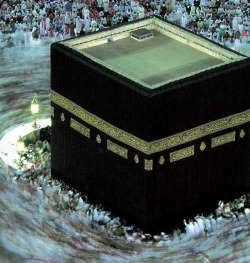
1) Muslims walk around the Ka’abah (black coloured cube building in Makkah) seven (7) times, often reciting several prayers. This is known as Tawaf.
2) Muslims pray behind a small chamber, called Maqaam-e-Ibrahim.
3) Muslims drink from the Zam Zam well.
4) Muslims walk seven times between the two mountains called Safa and Marwah. This is called Sa’ee.
5) After Sa’ee, a piece of hair is cut from the head and Muslims wear the Ihram (special clothing mentioned above). This is the start of the Hajj.
Location: MINA:
Night 1 of Hajj, Day 2 of Hajj:
(Islamic Date: 8th night and 9th day of Dhu Al-Hijjah)
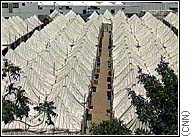
1) Muslims remember Allah by reciting prayers and his name repeatedly (Zhikr).
2) Muslims pray the five daily prayers, starting from Zuhr (the midday prayer) and finishing with Fajr (the morning prayer of the next day).
Location: ARAFAT:
Day 2 of Hajj:
(Islamic Date: 9th of Dhu Al-Hijjah)

1) Muslims remember Allah by reciting prayers and his name repeatedly (Zhikr).
2) Muslims ask for forgiveness here, as it is called Jable-Rahmah (literal meaning: Place of Mercy). They also confess their sins (Wuquf).
3) Muslims leave at sunset without praying the 4th daily prayer: Maghrib. This will be prayed at their destination: Muzdalifah.
Location: MUZDALIFAH:
Night 2 of Hajj, Day 3 of Hajj:
(Islamic Date: 9th night and 10th morning of Dhu Al-Hijjah)
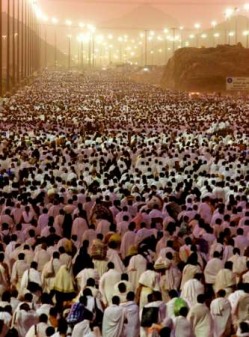
1) Muslims pray their Maghrib and Isha daily prayers (Salaah).
2) Muslims try to stay awake the whole night to remember Allah by reciting his name or other prayers (Zhikr).
3) Muslims pick a minimum of 49 small stones, which are used to pelt the devil at their next destination: Mina.
4) Muslims pray their Fajr prayer (morning Salaah).
Location: MINA:
Day 3 of Hajj:
(Islamic Date: 10th Dhu Al-Hijjah)

(This is the day that Eid is celebrated by Muslims worldwide).
1) Muslims pelt the first devil with seven stones. (There are three walls to represent the three devils). The devils are known as Jamarahs.
2) Muslims sacrifice an animal.
3) Muslims cut a piece of their hair. This allows them to remove the Ihram and to wear civilian clothing.
Location: MAKKAH:
Day 3 of Hajj:
(Islamic Date: 10th of Dhu Al-Hijjah)
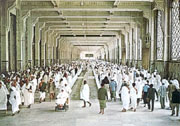
1) Muslims perform the Tawaf: walking around the Ka’abah (black cubed mosque) seven times.
2) Muslims perform the Sa’ee: walking seven times between the mountains of Safa and Marwah.
3) Muslims head back to Mina
Location: MINA:
Night 3 of Hajj, Days 4 and 5 of Hajj:
(Islamic Date: 10th night, 11th and 12th days of Dhu Al-Hijjah)
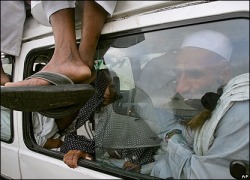
1) Muslims dedicate the night to Zhikr (remembrance of Allah).
2) On the 11th and 12th of Dhu Al-Hijjah (4th and 5th days of Hajj), Muslims pelt the three devils with the remaining stones. This symbolizes defiance against evil and temptation.
3) Apart from the daily prayers, Muslims also perform many extra prayers.
Location: MAKKAH:
Day 5 of Hajj:
(Islamic Date: 12th of Dhu Al-Hijjah)
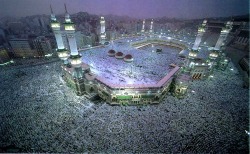
1) Muslims must arrive at Makkah before the 3rd prayer of Asr to complete their Hajj. If they do not make it, they must stay one more night in Mina to complete the Hajj.
Significance of Places Visited During Hajj and Their Relation to the Prophets:
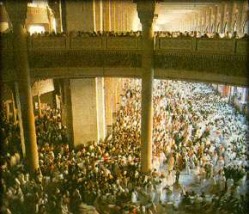
1) KA’ABAH: As Muslims perform Tawaf (going around the cubed mosque – Ka’abah – 7 times), they remember Adam (a.s.) who was the first person to build the Ka’abah. They also remember Ibrahim (a.s.) and Ismail (a.s.) who rebuilt the building after it was damaged during flooding.
2) MAQAAM-E-IBRAHIM: When praying behind the chamber called ‘Maqaam-e-Ibrahim,’ Muslims remember the Prophet Ibrahim (Abraham) (a.s.) because they believe that the chamber encloses the impression of Ibrahim’s (a.s.) feet.
3) HAJRE ASWAD: Literally, the Black Stone. The Prophet Muhammad (s) placed this stone in a corner of the ka’abah, so Muslims remember the story and recall the Prophet (a.s.).
4) SA’EE: Muslims believe that Bibi Hajra (r.a.) was the mother of Ismail (a.s.) and she ran between the two mountains called Safa and Marwah in search of water for her child. Muslims copy her actions to remember her anguish and experience what she experienced all those years ago. In the story, Ismail (a.s.) kicked one of the rocks and water came gushing out. This water was called Zam Zam water, and the well is still preserved in Makkah today. When on Hajj, Muslims drink this water as part of their experience.
5) MINA: Muslims believe that Ibrahim (a.s.) had a dream. In that dream, he was commanded to sacrifice his son, Ismail (a.s.) as part of a test to see how devoted he was to Allah. At the time, he did not know that and so, after great anguish, he closed his eyes and brought the knife down. However, Ismail (a.s.) was replaced by a ram and so Ibrahim (a.s.) passed the test. He pelted the three devils with stones, which Muslims also do as part of the Hajj. It symbolizes resistance to temptation, obedience, submission and devotion to Allah.
6) ARAFAT: Arafat is connected to Adam (a.s.) who asked for forgiveness from Allah here. The Last Sermon by the Prophet Muhammad (s.a.w.) also took place here, so Muslims confess their sins and ask for forgiveness, believing that Arafat is the Place of Mercy. The Day of Judgement is also believed to take place at Arafat. Therefore, this place has a connection to all the past Prophets as they all preached the same thing.
Conclusion...
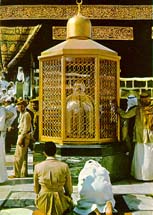
Hajj is a life-changing experience for every Muslim, if they are sincere. Every year, millions of Muslims gather together to perform the same rituals, and sacrifice their worldly lives for the one chance to be forgiven all their sins and to become better Muslims.
This is the last of the Five Pillars / Fundamental Beliefs of Islam and it has a big impact in strengthening one’s awareness and faith in Allah (Taqwa). An example of a person who was dramatically affected by the Hajj would be Malcolm X, who realized that there is no status/superiority/inferiority because of race. He saw that Muslims of different races, countries and languages all gathered together under the banner of Islam in harmony, united in their love for Allah.
